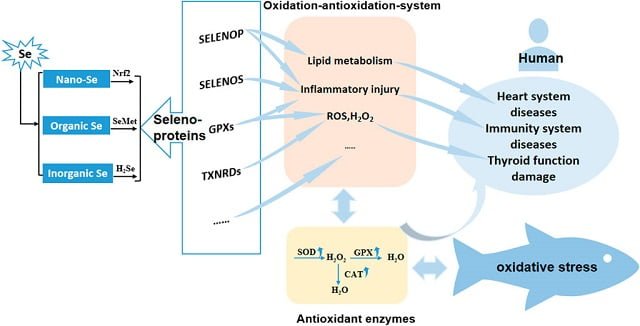
Selenium (Se) is an essential micronutrient for the growth, health, and development of animals. The biological functions of selenium include promoting growth and development, enhancing the body’s antioxidant capacity, preventing oxidative stress, boosting immunity, and its wide usage in aquaculture animals.
The intensification of aquaculture comes hand in hand with adverse conditions for aquaculture species, such as overcrowding, hypoxia, and malnutrition. This promotes the production of excessive reactive oxygen species (ROS), disrupts the oxidation balance, and leads to oxidative stress.
In this regard, a team of researchers from Dalian Ocean University, Hebei Normal University of Science and Technology, and China Agricultural University published a scientific review summarizing the application and progress in selenium research in oxidative stress in aquatic animals.
The paper reviews the physiological functions of selenoproteins in resisting oxidative stress in aquatic animals, the mechanisms of different forms of selenium in antioxidative stress, and the dangerous effects of low and high levels of selenium in aquaculture.
The role of selenoproteins in the antioxidant system
In general, sources of selenium in animals will first convert into selenides to function in organisms and then convert into proteins containing selenocysteine (Sec), namely selenoproteins that will be absorbed and utilized by organisms.
During the fish farming process, any pressure condition will directly or indirectly cause oxidative stress, leading to increased levels of intracellular ROS, causing destructive effects on lipids, proteins, and DNA.
As an effective antioxidant, selenium plays an important role in the antioxidant defense system of aquaculture animals.
Application of different forms of selenium
In many studies, selenium has been found to alleviate oxidative stress caused by hypoxia, overcrowding, heavy metal contamination, intake of oxidized oil, and other pressure conditions.
The study reports the use of inorganic selenium in rainbow trout to inhibit lipid peroxidation, inhibit antioxidant transcript levels, and inhibit blood glutathione levels. Meanwhile, Nile tilapia inhibits lipid peroxidation in the gills and participates in fish excretion.
Likewise, organic selenium has been employed in whiteleg shrimp, where it is reported to protect the cell membrane from oxidative damage and participate in the metabolism of polyunsaturated fatty acids.
Dangerous effects of selenium excess
Excessive selenium levels have some toxic effects. When the selenium content in the diet of aquaculture animals is slightly higher than required, it has adverse effects, including oxidative stress, cytotoxicity, and genotoxicity.
In fish exposed to excessive selenium levels, the degree of oxidative stress in the body can significantly increase.
For example, in Atlantic salmon, high levels of selenium (at least 15 mg/kg in the diet) can lead to oxidative stress and alter the metabolism of organic and inorganic selenium lipid. In the case of sturgeon, excess selenium in the diet causes vacuolar degeneration of cells and liver necrosis.
Dangerous effects of selenium deficiency
Various research has reported that selenium deficiency is closely related to the occurrence of many diseases in aquatic animals and the impairment of physiological functions in various conditions.
Additionally, selenium deficiency can inhibit organ growth and reduce immune functions, leading to many inflammatory diseases.
“It has been demonstrated that selenium is a protective trace element in the liver of many animals. Selenium deficiency can cause immunodeficiency, inhibit fish growth, and induce oxidative stress in the liver,” the researchers quoted.
The study describes that selenium deficiency also affects the structural integrity of the head, kidney, spleen, and skin of juvenile herbivorous carp, leading to oxidative damage and exacerbating cell apoptosis due to the negative regulation of antioxidant enzyme activities.
Effects of selenium-rich fish on human health
Fish are a type of food with the highest natural selenium content, rich in minerals, proteins, and vitamins. Additionally, fish raised and fed with a selenium-rich diet can be processed and prepared as foods with bioactive peptides.
In this sense, consuming selenium-rich fish can improve the absorption rate of selenium in humans, and selenium supplementation is more efficient.
Research reports indicate that selenium can reduce the incidence rate of heart disease in humans.
Conclusion
“Selenium is an essential mineral element for combating oxidative stress in aquatic animals and plays an important role in the antioxidant system of aquaculture,” the researchers conclude.
The researchers recommend conducting further studies to identify the most effective form of selenium in the antioxidant system of aquatic animals. Additionally, they suggest selectively preventing oxidative stress in aquaculture animals, clarifying the mechanism of selenoproteins in the antioxidant system of aquatic animals, and providing guidance for studying selenium toxicity.
The study was funded by the Innovation Team Project of Dalian Ocean University, China, and the Central Guidance on Local Science and Technology Development Fund of Hebei Province, China.
Referencia (acceso libre)
Li, Z. M., Wang, X. L., Jin, X. M., Huang, J. Q., & Wang, L. S. (2023). The effect of selenium on antioxidant system in aquaculture animals. Frontiers in Physiology, 14, 274.
Editor at the digital magazine AquaHoy. He holds a degree in Aquaculture Biology from the National University of Santa (UNS) and a Master’s degree in Science and Innovation Management from the Polytechnic University of Valencia, with postgraduate diplomas in Business Innovation and Innovation Management. He possesses extensive experience in the aquaculture and fisheries sector, having led the Fisheries Innovation Unit of the National Program for Innovation in Fisheries and Aquaculture (PNIPA). He has served as a senior consultant in technology watch, an innovation project formulator and advisor, and a lecturer at UNS. He is a member of the Peruvian College of Biologists and was recognized by the World Aquaculture Society (WAS) in 2016 for his contribution to aquaculture.
